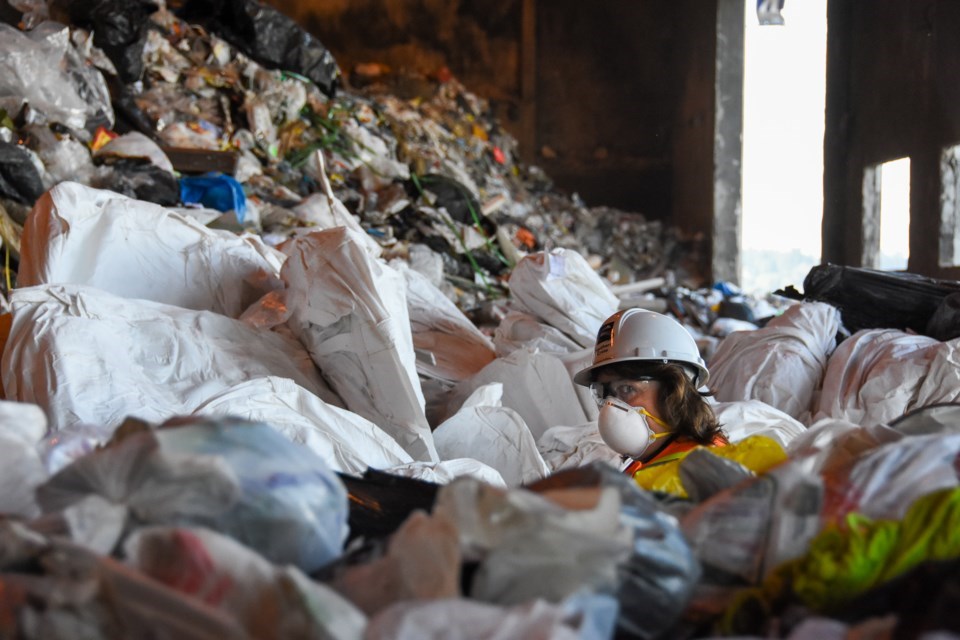The City of Vancouver and the B.C. government have invested over $8.5 million to expand the capture of methane gas emitted from a regional landfill and convert it into fuel.
The money will go toward installing a new system of wells, collectors and piping to capture and turn greenhouse gases emitted from the Vancouver landfill — located next to Burns Bog in Delta — into renewable gas.
“The Vancouver landfill project will remove an estimated 485,000 tonnes of carbon-dioxide equivalent over the next decade,” said Minister of Environment and Climate Change Strategy George Heyman in front of Vancouver City Hall Monday.
“This is a huge opportunity to replace fossil fuels and provide people, businesses and the city with low-carbon alternatives made from organic waste.”
Renewable gas (RNG) is the catch-all term to describe all methane captured from wastewater treatment plants, landfills and manure from farm animals. Even wood waste and municipal organics can be placed into a digester tank, where 'biogas' is captured and then purified.
What comes out resembles conventional Liquefied Natural Gas (LNG), largely methane, which if left to seep into the air acts as a greenhouse gas up to 84 times more potent than carbon dioxide over a 20-year period.
By re-purposing methane that would otherwise be emitted into the atmosphere, advocates of renewable gas capture technology tout it as a carbon-neutral solution that doesn't require a massive overhaul of public and private infrastructure.
FortisBC plans for 15 per cent of its natural gas supply to come from renewable sources by 2030, claiming it will reduce customer emissions by 30 per cent.
“By the end of this year, we have almost tripled our annual RNG supply from 2012, and with new supply expected to come online, we forecast that by the end of 2022, we'll triple that number again,” said FortisBC’s vice-president of energy supply and resource development Joe Mazza.
FortisBC has said including gas in B.C.’s move away from fossil fuels would cost $100 billion less by mid-century compared to outright electrification, while still enabling the province to meet its emissions targets.
Environmental groups have criticized fossil fuel companies such as Fortis for a coordinated marketing campaign that places too much emphasis on the role of natural gas as the world works to decarbonize.
In a 2020 report, Earthjustice and Sierra Club concluded that renewable gas is between four and 17 times more costly than traditional natural gas. The Canadian Association of Physicians for the Environment have consistently warned that natural gas poses significant threats to people’s health when burned indoors. Transportation of the gas, meanwhile, risks the same fugitive emissions leaking into the atmosphere as traditional natural gas.
But all of those concerns pale in comparison to an emerging battle of ideas between B.C.’s two biggest utilities: BC Hydro and FortisBC have recently traded barbs on Twitter over how the province’s buildings should be heated going forward.
B.C. UTILITIES AT EACH OTHER'S THROATS
In recent weeks, BC Hydro has been arming itself with a mandate to increasingly electrify the province. Released in September, the utility's Electrification Plan offers a path to target the electrification of homes, businesses and industry; and in a call to electrify last week, BC Hydro said British Columbians are failing to understand how much their gas furnaces were contributing to climate change.
Since then, the electric utility’s communication team has opened up an unprecedented campaign to convince FortisBC customers to swap their gas furnaces for a heat pump.
“Did you know that heating your home with natural gas contributes to climate change?” BC Hydro tweeted Oct. 12.
“Did YOU know that by using 100% Renewable Natural Gas your home furnace could be carbon-neutral and still about $140 dollars cheaper a year than using an electric heat pump?” responded FortisBC.
That’s when the Spiderman memes started flying back and forth.
According to Andrew Gage, a lawyer focusing on climate policy at West Coast Environmental Law, neither utility has been honest about the limitations of gas and electricity.
Burning renewable gas is not a viable alternative to an electric heat pump, he says. In Vancouver, for example, burning natural gas to heat buildings releases roughly 54 per cent of all greenhouse gas emissions in the city.
The city’s Zero Emissions Building Plan and Green Buildings Policy for Rezonings would require all new buildings to be emissions-free by 2030, which essentially translates into a ban on natural gas for heating within a decade, unless enough RNG can be produced by then.
Detractors of any plan to swap conventional gas for renewable gas say it only delays the full-scale electrification of thousands of skyscrapers, three-storey walkups and detached homes.
But renewable gas still has value, says Gage. Instead of heating buildings, he says we’re going to need all the renewable gas we can get for industries and processes that currently use fossil fuels and for which no alternatives exist. That includes shipping, heavy industry, and for the time being, heavy-duty trucks.
“We should not be burning RNG to warm houses when there are readily available ways to do that through electricity, and we certainly should not be expanding the number of houses on gas furnaces,” says Gage. “FortisBC’s tweet, while good marketing from their point of view, is irresponsible from a climate perspective.”
Further, says Gage, the idea that a customer can easily get 100 per cent renewable gas is complicated by the company’s own internal policies.
He points to FortisBC’s webpage on RNG, which notes that when the company doesn't have enough renewable gas supply, it has the right to "purchase offsets."
With files from Nelson Bennett
Stefan Labbé is a solutions journalist. That means he covers how people are responding to problems linked to climate change — from housing to energy and everything in between. Have a story idea? Get in touch. Email [email protected].




